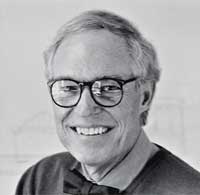Niels Diffrient
Niels Diffrient | |
|---|---|
 | |
| Born | 6 September 1928 |
| Died | 8 June 2013 (aged 84) Ridgefield |
| Occupation | Industrial designer |
| Awards |
|
Niels Diffrient (6 September 1928 – 8 June 2013) was an
Biography
Diffrient was born in 1928 in a farmhouse near Star, Mississippi.[1]
During the Great Depression his family relocated to Detroit, where Diffrient attended Cass Technical High School. He then attended Wayne State University, and finally Cranbrook Academy of Art, where he received a Bachelor of Fine Arts in architecture and excelled as an outstanding student, winning the First Medal in Design three of his four years there.
While in
Upon arriving back in the United States in 1955, Diffrient joined Dreyfuss Associates in their Pasadena offices, and spent the next few decades revolutionizing American industrial design through his development of interiors and corporate identity for American Airlines planes, the landmark Princess telephone, the Polaroid SX-70 camera, and tractor seats for John Deere.[2] In 1980 after 25 years with Henry Dreyfuss Associates, Diffrient left to start his own independent practice, establishing a design studio in Ridgefield, Connecticut which he shared with his wife, tapestry artist Helena Hernmarck.[3]
In his career, which lasted over a half century, Diffrient designed every type of equipment, as well as
Additionally, Niels spent time as adjunct Professor of Design at
Articles about him and his work have appeared in Time Magazine, Fortune, Business Week and The New York Times to name a few.
Diffrient died on 8 June 2013 at his home in Ridgefield, Connecticut.[4]
Awards
In the field of furniture design, most notably ergonomic seating, Diffrient won a total of 24 awards, including two Best of Show and 10 Gold and Top awards. He cited in more than 46 design and utility patents on furniture designs in America and abroad. Other honors include the
Products designed by Niels Diffrient

Humanscale
Humanscale is an American company based in New York City, best known for its Freedom chair designed by Niels Diffrient and introduced in 1999.[9][10][11]
Chairs:
- Freedom Chair, 1999: The chair was considered innovative for its internal
- Liberty Chair, 2004: Humanscale’s other notable task chair is its Liberty chair, also designed by Niels Diffrient, which was introduced in 2004. The Liberty chair is a tri-panel mesh back design, which allegedly provides lumbar support.[15] Like the Freedom chair, Liberty is also outfitted with a balanced recline mechanism that is supposed to support all sitters throughout recline.
- Diffrient World Chair, 2009
Humanscale also manufactures keyboard support systems, monitor arms, task lighting, and various other
- Diffrient Task and Work Light, 2002
Other
- Diffrient Chair (Knoll), 1979
- Helena Chair and Jefferson Chair (SunarHauserman), 1984
- Flexible Workspace Furniture System (KI), 1998
- John Deere tractors (Henry Dreyfuss)
- Borletti Sewing Machine (Marco Zanuso)
- Confessions of a Generalist (Generalist Ink, LLC)
Publications
ISBNs for the books listed. . (May 2017) |
- Diffrient, Niels. Humanscale: Manual. Cambridge, Mass: MIT Press, 1974. Print.
- Diffrient, Niels, Mildred S. Friedman, Joan Bardagjy, and Nicholas Polites. Dimensions of Experience: Understanding and Measuring Human Experience in the Designed Environment. Minneapolis, Minn: Walker Art Center, 1975. Print.
- Diffrient, Niels. Confessions of a Generalist. Danbury, Conn.: Generalist Ink, LLC, 2012. Print.
- Lutz, Brian. Eero Saarinen: Furniture for Everyman. New York: Pointed Leaf Press, 2012. Print.
- Pedersen, Martin C. "Niels Diffrient." Metropolis: Architecture Design 32.8 (2013): 88. Biography Reference Bank (H.W. Wilson). Web. 10 Dec. 2015.
References
- ^ contractmagazine.com, Human Factor: A tribute to Niels Diffrient , accessed July 19, 2007.
- ^ a b Dorris, Jesse (20 June 2013). "Remembering the Genius of Niels Diffrient". Interior Design. Archived from the original on 22 October 2013. Retrieved 22 October 2013.
- ^ Blake, Peter (1994). "Diffrient/Hernmarck". Interior Design. 65 (10): 140.
- ^ Yardley, William (16 June 2013). "Niels Diffrient, Industrial Designer Who Blended Form and Function, Dies at 84". The New York Times. Retrieved 12 September 2013.
- ^ "Contract Magazine". Archived from the original on 2008-05-09. Retrieved 2008-05-09.
- ^ "Humanscale".
- ^ "Past Royal Designers for Industry". The RSA. Retrieved 2022-09-27.
- ^ "Remembering Niels Diffrient | Cooper Hewitt, Smithsonian Design Museum". www.cooperhewitt.org. 2013-06-14. Retrieved 2022-11-21.
- ^ a b Humanscale History Archived 2011-04-11 at the Wayback Machine
- ^ Edge Foundation
- ^ "Niels Diffrient". Industrial Designers Society of America. 9 February 2010. Archived from the original on 4 October 2012. Retrieved 13 September 2012.
- ^ Viladas, Pilar (30 November 2003). "Questions for Niels Diffrient – A Machine for Sitting". The New York Times. Retrieved 13 September 2012.
- ^ Wired.com, The Hot Seat
- ISBN 978-0-7148-6103-6.
- ^ Metropolis Magazine, Machines for Sitting: The complex job of making your office chair simple "Archived copy" (PDF). Archived from the original (PDF) on 2011-07-25. Retrieved 2011-04-19.
{{cite web}}: CS1 maint: archived copy as title (link)
External links
- [Remembering the Genius of Niels Diffrient][1]
- [The Story Of Industrial Designer Niels Diffrient][2]
- Chrysler Design Awards
- Freedom Chair
- Liberty Chair
- Niels Diffrient Bio: Contract Magazine[permanent dead link]
- Neils Diffrient Bio: Design Within Reach
- Niels Diffrient rethinks the way we sit down - Video on TED.com
- Archives of American Art Oral History Interview with Niels Diffrient, 2010
- Henry Dreyfuss Associates
- Niels Diffrient at TED
